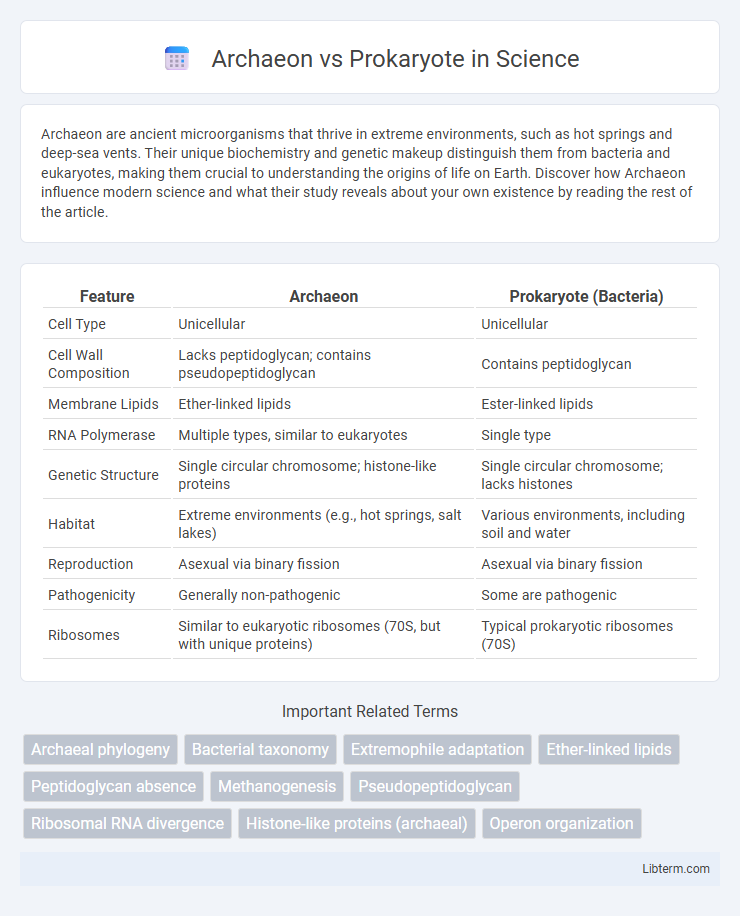Archaeon are ancient microorganisms that thrive in extreme environments, such as hot springs and deep-sea vents. Their unique biochemistry and genetic makeup distinguish them from bacteria and eukaryotes, making them crucial to understanding the origins of life on Earth. Discover how Archaeon influence modern science and what their study reveals about your own existence by reading the rest of the article.
Table of Comparison
| Feature | Archaeon | Prokaryote (Bacteria) |
|---|---|---|
| Cell Type | Unicellular | Unicellular |
| Cell Wall Composition | Lacks peptidoglycan; contains pseudopeptidoglycan | Contains peptidoglycan |
| Membrane Lipids | Ether-linked lipids | Ester-linked lipids |
| RNA Polymerase | Multiple types, similar to eukaryotes | Single type |
| Genetic Structure | Single circular chromosome; histone-like proteins | Single circular chromosome; lacks histones |
| Habitat | Extreme environments (e.g., hot springs, salt lakes) | Various environments, including soil and water |
| Reproduction | Asexual via binary fission | Asexual via binary fission |
| Pathogenicity | Generally non-pathogenic | Some are pathogenic |
| Ribosomes | Similar to eukaryotic ribosomes (70S, but with unique proteins) | Typical prokaryotic ribosomes (70S) |
Introduction to Archaea and Prokaryotes
Archaea represent a distinct domain of single-celled microorganisms characterized by unique genetic, biochemical, and metabolic traits that differentiate them from bacteria within the prokaryote category. Prokaryotes encompass both Bacteria and Archaea, organisms lacking a membrane-bound nucleus and organelles, but Archaea possess distinct membrane lipids and gene expression mechanisms. Understanding the structural and biochemical differences of Archaea is essential for studying their ecological roles and evolutionary relationships with other prokaryotes.
Defining Prokaryotes: Bacteria and Archaea
Prokaryotes include two primary domains: Bacteria and Archaea, both lacking a membrane-bound nucleus and other organelles found in eukaryotes. Bacteria possess peptidoglycan in their cell walls, whereas Archaea display distinct lipid membranes and unique metabolic pathways adapted to extreme environments. Genetic analyses reveal significant differences in ribosomal RNA sequences, underscoring the evolutionary divergence between these two groups within prokaryotic life.
Unique Characteristics of Archaea
Archaea possess distinctive lipid membranes composed of ether-linked isoprenoid chains, contrasting with the ester-linked fatty acids found in prokaryotes. Their genetic machinery, including RNA polymerase and ribosomal proteins, exhibits closer similarities to eukaryotes, highlighting unique evolutionary pathways. Furthermore, many archaea thrive in extreme environments such as high temperature, salinity, or acidity, showcasing specialized metabolic pathways like methanogenesis absent in typical prokaryotes.
Structural Differences: Archaea vs. Bacteria
Archaeon cell walls lack peptidoglycan, instead containing pseudopeptidoglycan or unique polysaccharides, differentiating them structurally from bacterial cell walls rich in peptidoglycan. Archaeal membrane lipids feature ether bonds linking isoprenoid chains to glycerol, contrasting with bacterial ester-linked fatty acid membranes. Ribosomal RNA sequences and protein synthesis machinery in archaea exhibit closer similarity to eukaryotes than to bacteria, underscoring fundamental molecular structural distinctions.
Genetic and Molecular Distinctions
Archaea possess unique genetic machinery distinct from prokaryotes, including multiple types of RNA polymerases more similar to eukaryotes, and their genes contain introns unlike typical prokaryotic genes. Archaeal membranes feature ether-linked lipids, contrasting the ester-linked lipids found in bacterial prokaryotes, influencing molecular stability and environmental adaptability. Their ribosomal RNA sequences and histone-like proteins further differentiate them at the molecular level, reflecting evolutionary divergence despite prokaryotic morphology.
Environmental Adaptations of Archaea
Archaea exhibit remarkable environmental adaptations, thriving in extreme conditions such as high temperatures, salinity, acidity, and anaerobic environments, which distinguish them from typical prokaryotes like bacteria. Their unique lipid membranes, ether-linked lipids, and specialized enzymes enable stability and functionality under extreme heat and chemical stress. These adaptations allow archaea to colonize niches such as hydrothermal vents, salt flats, and acidic hot springs, environments often inhospitable to most prokaryotic life forms.
Metabolic Pathways and Energy Production
Archaea exhibit unique metabolic pathways distinct from typical prokaryotes, often utilizing methanogenesis, a process absent in bacteria, for energy production. Their energy metabolism includes the ability to oxidize inorganic compounds such as sulfur or hydrogen, enabling survival in extreme environments. Prokaryotes, particularly bacteria, predominantly rely on glycolysis and oxidative phosphorylation, employing diverse electron acceptors like oxygen, nitrate, or sulfate in their energy metabolism.
Evolutionary Relationships and Phylogeny
Archaea and prokaryotes exhibit distinct evolutionary relationships, as Archaea form a separate domain more closely related to Eukarya than Bacteria, despite both being prokaryotic. Phylogenetic analyses based on ribosomal RNA sequences reveal that Archaea share a common ancestor with Eukaryotes, indicating a unique lineage divergent from bacterial prokaryotes. This evolutionary distinction highlights the significance of Archaea in understanding the tree of life and molecular evolution across different domains.
Roles in Ecosystems and Biotechnology
Archaea contribute to ecosystems by driving biogeochemical cycles such as methane production and nitrogen fixation, often thriving in extreme environments where prokaryotes may be less effective. Prokaryotes, including bacteria, play crucial roles in decomposing organic matter and nutrient recycling, supporting soil fertility and plant growth. Both archaea and prokaryotes are exploited in biotechnology for applications like bioremediation, biofuel production, and the synthesis of enzymes used in industrial processes.
Conclusion: Key Differences and Similarities
Archaea and prokaryotes both lack a nucleus and membrane-bound organelles, distinguishing them from eukaryotes, yet archaea possess unique genetic and biochemical traits such as ether-linked lipids and distinct ribosomal RNA sequences. Prokaryotes encompass both bacteria and archaea, but archaea share closer evolutionary relationships with eukaryotes based on molecular and genetic similarities. These differences and similarities highlight the evolutionary significance of archaea as a distinct domain within prokaryotic life forms.
Archaeon Infographic

 libterm.com
libterm.com